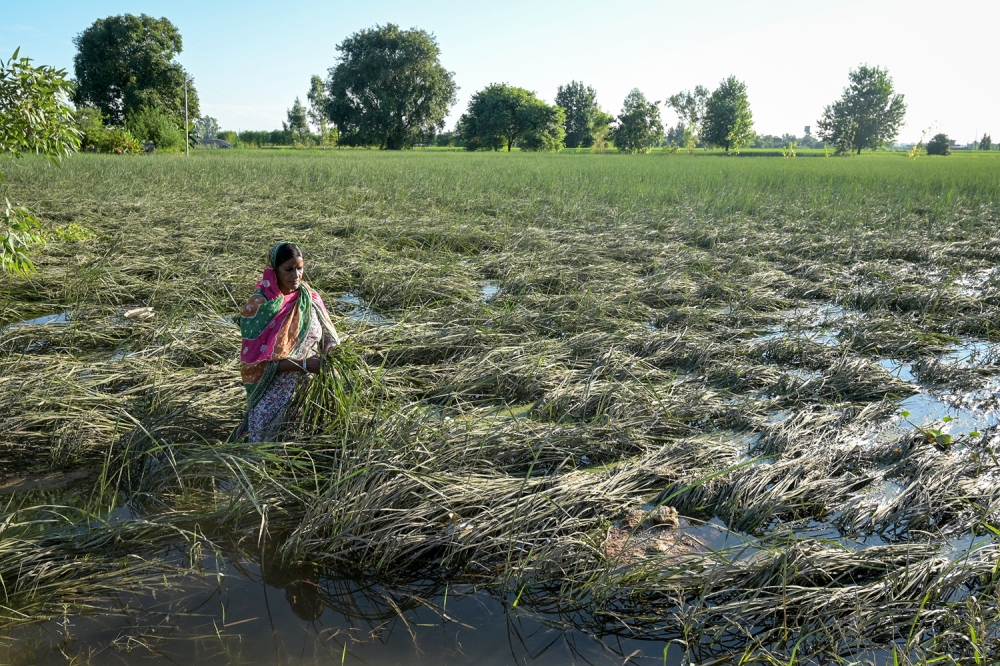An hour away by car from the busy Indian port city of Visakhapatnam, the countryside is changing rapidly. Vast stretches of what once were paddy fields are now home to gleaming, modern housing developments.
A generation ago, this land would have grown all manner of crops from rice and sesame seeds to sugar cane and banana plants. But climate change is driving a rapid transformation. With crops routinely withering and dying, farmers must now look elsewhere for a living. It is just one symptom of India’s shifting agricultural landscape, as many farmers are wading through impossible choices forced on them by a changing climate.
Soaring heat waves, increasingly frequent cyclones, and disrupted rain cycles—the southeast coast of India is deeply vulnerable to these extreme weather events caused by climate change, and few feel that more acutely than the country’s farmers. Most of them have worked the land their entire lives, but climate change is now forcing them into an impossible choice: Leave their homes in search of work elsewhere or stay put and try to adapt to an era of climate catastrophe.
India is rapidly urbanizing, with the percentage of its population living in urban areas jumping from around 28 percent in 2000 to 37 percent in 2024, according to data from the World Bank, and that is likely to keep growing even faster. The economy has expanded quickly alongside India’s cities, but rural areas are struggling with a loss of labor and a rapidly shifting environment.
“One of the major effects of climate change is insecticides. Far more insects are swarming around, and they’re getting inside the crops,” K.S. Naidu said. He owns several acres of land in the district of Vizianagaram, which once grew copious rice crops. But with climate change making his business less viable, he went into construction instead and now allows his land to be used for developing houses and flats.
Uncertainty is rife among India’s farmers. Without proper pesticides, growing swarms of insects can ruin an entire season’s crop, while disrupted weather cycles make once predictable harvest patterns harder to forecast.
India’s rapid urbanization is driving land values up, making it more tempting to sell. “The insects are increasingly becoming immune to the pesticides,” Naidu said. “The whole crop can be lost due to the insects. The pesticides can be very expensive.”
Visakhapatnam, known to the locals as Vizag, sits on the Bay of Bengal, surrounded by mountains on three sides. Uncontrolled urban growth and its coastal location have left it particularly vulnerable to climate change.
In 2014, the city and its surrounding countryside were struck by a devastating cyclone called Hudhud, which uprooted almost all of the area’s trees and left an impact that’s still visible today. The cyclone caused more than $3 billion in damage, according to the state government, and few felt it more than the farmers and fishermen whose livelihoods were uprooted along with the greenery.
But while Hudhud might have been seen as a once-in-a-generation storm, climate change is making such catastrophic weather events more common. Severe storms and disrupted rain cycles—which are becoming more pronounced as the effects of global warming take hold—can ruin an entire year’s crops.
Farmer P.L. Naidu, based in the small nearby town of Mangalapalem, said that more than half of the area’s farmers have left to seek employment elsewhere. He now struggles to find local farmworkers, often counting on labor from further afield to help at the busiest times of the year.
Y. Sunder Rao, a farmer from Vizianagaram, said the soaring costs of running a farm are only getting worse because of climate change.
“We do everything manually here, we are not yet used to mechanized farming,” Rao said. “Rising labor costs has meant the cost of cultivation is rising substantially. Because of climate change, the amount of rainfall we get has fallen considerably. So now we have to depend on groundwater. To cultivate one acre of land, I have to spend 1,000 rupees [$11.68], as well as labor costs to ensure the water flows. It’s becoming very expensive.”
Livestock farmers are also struggling with the effects of rising temperatures across southern India. Temperatures in the Vizianagaram district routinely sit at well over 30 degrees Celsius for much of the year. Keeping the animals cool, well-fed, and in good health is another growing cost for many famers.
“A farmer who has 10 cows here might spend 40,000 rupees [$467.59] per month looking after their animals,” Rao said. “But this will typically be as much as they earn.”
Many farmers are opting to stay put, regardless of whatever storms head their way. But that can mean suddenly losing entire years’ worth of income. Disrupted rain cycles can ruin rice and fruit crops, heat waves kill livestock, and tropical storms can uproot entire villages.
For those who leave, the choices are often narrow. Many struggling former farmers end up working as construction hands, fueling the rapidly expanding skylines of major cities across India. In Visakhapatnam alone, advertisements for new luxury developments are plastered across billboards throughout the city center.
But many workers find themselves working in dangerous, crowded conditions as they try to make a new living.
While there are government schemes aimed at helping farmers who are struggling to adapt to the changes, Rao said the help is failing to reach remote areas in the coastal belt. “Agricultural production is definitely falling across the country. In some areas where there is better access to water resources, it is still thriving,” he said. “But when your farm is close to a city, the city will take away so much employment. Slowly, places all around us are becoming concrete jungles.”
Farmers in India gained international attention in 2020 for a major protest against three bills put forward by the country’s central government—which drew international solidarity and eventually saw the legislation repealed.
But farming communities across India still suffer from difficult working conditions and a high suicide rate on top of the growing climate-related crises.
“The future of agriculture is very bleak,” Rao said. “In previous generations, sons would become farmers after their fathers. Now this is no longer the case. Now farmers are choosing to get their children educated.”
But despite the challenges, the village’s farmers are still proud of their work, their land, and their livelihoods. The sector may be in decline, but it still accounts for more than half of India’s total workforce and nearly 20 percent of its GDP, according to an economic survey.
“Farmers are our kings,” Rao said proudly. “Without farmers, nobody can live.”
The post Indian Farmers Struggle as Climate Change Warps Landscape appeared first on Foreign Policy.




